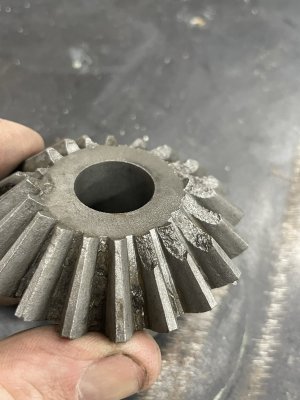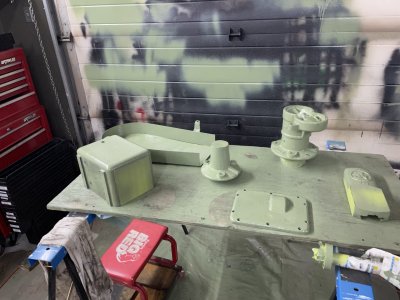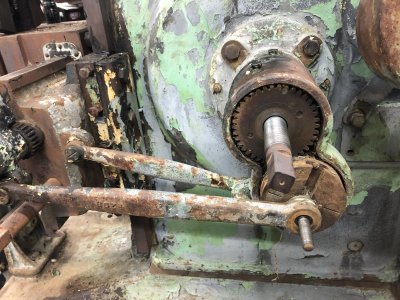-
Scam Alert. Members are reminded to NOT send money to buy anything. Don't buy things remote and have it shipped - go get it yourself, pay in person, and take your equipment with you. Scammers have burned people on this forum. Urgency, secrecy, excuses, selling for friend, newish members, FUD, are RED FLAGS. A video conference call is not adequate assurance. Face to face interactions are required. Please report suspicions to the forum admins. Stay Safe - anyone can get scammed.
-
Several Regions have held meetups already, but others are being planned or are evaluating the interest. The Calgary Area Meetup is set for Saturday July 12th at 10am. The signup thread is here! Arbutus has also explored interest in a Fraser Valley meetup but it seems members either missed his thread or had other plans. Let him know if you are interested in a meetup later in the year by posting here! Slowpoke is trying to pull together an Ottawa area meetup later this summer. No date has been selected yet, so let him know if you are interested here! We are not aware of any other meetups being planned this year. If you are interested in doing something in your area, let everyone know and make it happen! Meetups are a great way to make new machining friends and get hands on help in your area. Don’t be shy, sign up and come, or plan your own meetup!
You are using an out of date browser. It may not display this or other websites correctly.
You should upgrade or use an alternative browser.
You should upgrade or use an alternative browser.
Mystery Shaper rejuvenation
- Thread starter kevin.decelles
- Start date
Time for some re-assembly pics
Main bearing housing, attaches with 4-bolts and two-alignment pins
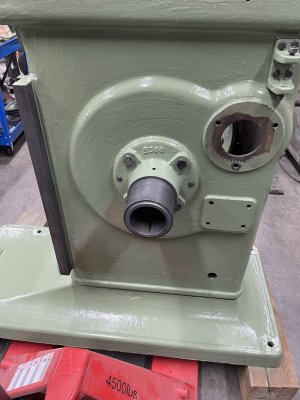
Secondary housing that slips over the main housing (such a nice fit, you can just hear it 'ring' as metal kisses metal.
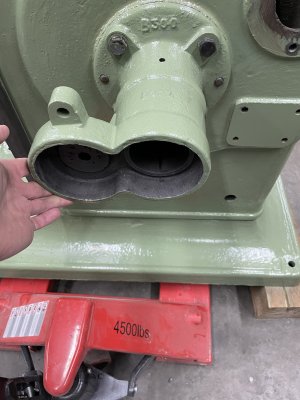
Casting for the knee screw.
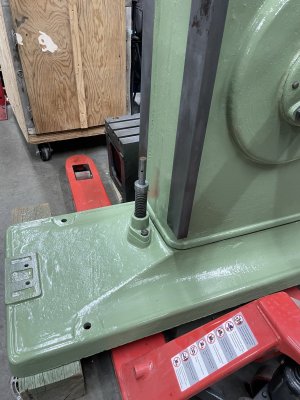
Bull gear installed and drive gear housing/gear installed


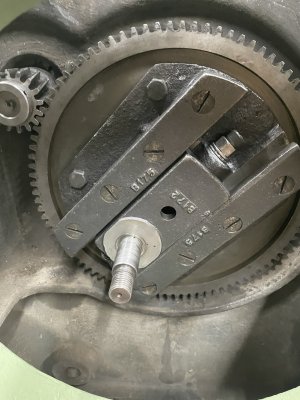
Main bearing housing, attaches with 4-bolts and two-alignment pins

Secondary housing that slips over the main housing (such a nice fit, you can just hear it 'ring' as metal kisses metal.

Casting for the knee screw.

Bull gear installed and drive gear housing/gear installed



Looking good Kevin, very nice work!
LeakyCanoe
Active Member
Question: in the third picture from the bottom the gear teeth look to be cut on an angle. Is it he picture angle or are they cu that way. If so, why? (perhaps stronger as they are slightly longer??)
Tom - check out this link for what I understand to be the explanation...
https://www.tec-science.com/mechanical-power-transmission/gear-types/helical-gears/
Tomc938
Ultra Member
Thanks! Reading the article everything makes sense. I never knew that about reverse. I mean I knew it was louder, just didn't know why.Tom - check out this link for what I understand to be the explanation...
https://www.tec-science.com/mechanical-power-transmission/gear-types/helical-gears/
I've never cut a bevel gear but Keith Rucker did a pretty good video on the process.
Last edited:
deleted_user
Super User
I've never cut a bevel gear buy Keith Rucker did a pretty good video on the process.
This is VERY handy skill to have if you want to make flywheel governor for a stationary steam engine...
LeakyCanoe
Active Member
...and when you get that shaper completed Kevin you can "cut your teeth" on it too !
Here's a handy link to doing that...
https://www.antiquemachinery.com/gear_cutting.htm
Here's a handy link to doing that...
https://www.antiquemachinery.com/gear_cutting.htm
Had a setback last night...... operator error, 100%.
Disassembling the yoke, had to press out the pins. First two pins went smoothly, third pin, ended up cracking the casting in two spots. Was pressing out from the top, didn't compensate for the pin being seized in the lower end. Next time..... will approach this differently.
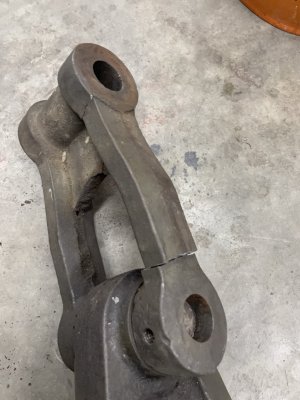
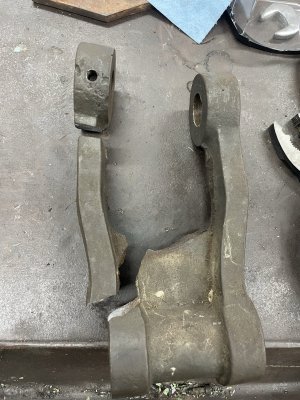
Ok, no point whining about it, my fault, but in looking at the casting ends, was there something at work here already? Look at the casting where it attached to the webbing, specifically the discoloration. Is this an indicator of anything (rust/oil/seepage, an existing crack?)

And for comparison, the other end:
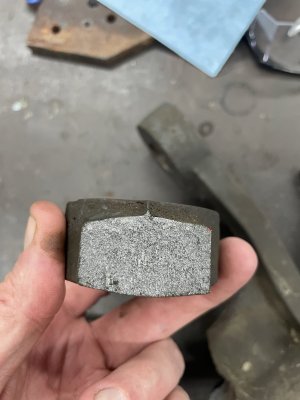
So, where is the silver lining? Well, it's not the RAM casting, or the bull-gear, or the table, or the apron. Of all the pieces to break, this one is hidden from view and I think there are multiple ways to approach the repair.
1. Braze/weld
2. Fabricate from steel
3. Cast one from Aluminum?
This piece attaches to the main casting at the bottom with a 1" pin. the other side is the pivot for the yoke, so lots of rocking back/forth, but the lion share of the load is handled by the slide-block /bull-gear.
I've never had great success at brazing or welding cast. My spider sense tells me that the strength won't be there. I'll always have the part for reference, and having it in the machine would be ideal but isn't critical to me. Fabricating a piece out of steel is probably the sure bet, and the easiest to do. Casting one out of aluminum is also doable. The strength of an aluminum casting doesn't worry me -- think swing-arm on any motorcycle.
Any how, part of the journey is making mistakes. If I were pressing it out again I'd have shimmed all gaps between the pieces so there was no play, or pre-heated/soaked with penetrating oil, or all the above.
Disassembling the yoke, had to press out the pins. First two pins went smoothly, third pin, ended up cracking the casting in two spots. Was pressing out from the top, didn't compensate for the pin being seized in the lower end. Next time..... will approach this differently.


Ok, no point whining about it, my fault, but in looking at the casting ends, was there something at work here already? Look at the casting where it attached to the webbing, specifically the discoloration. Is this an indicator of anything (rust/oil/seepage, an existing crack?)

And for comparison, the other end:

So, where is the silver lining? Well, it's not the RAM casting, or the bull-gear, or the table, or the apron. Of all the pieces to break, this one is hidden from view and I think there are multiple ways to approach the repair.
1. Braze/weld
2. Fabricate from steel
3. Cast one from Aluminum?
This piece attaches to the main casting at the bottom with a 1" pin. the other side is the pivot for the yoke, so lots of rocking back/forth, but the lion share of the load is handled by the slide-block /bull-gear.
I've never had great success at brazing or welding cast. My spider sense tells me that the strength won't be there. I'll always have the part for reference, and having it in the machine would be ideal but isn't critical to me. Fabricating a piece out of steel is probably the sure bet, and the easiest to do. Casting one out of aluminum is also doable. The strength of an aluminum casting doesn't worry me -- think swing-arm on any motorcycle.
Any how, part of the journey is making mistakes. If I were pressing it out again I'd have shimmed all gaps between the pieces so there was no play, or pre-heated/soaked with penetrating oil, or all the above.
So what did go right yesterday? The electric motor re-assembly! put the pieces back together and replaced the through-rods and bearings. Fired it up and it is whisper quiet now. And yes, there is a missing piece in the pulley-end cooling fin casting -- this was pre-existing, I didn't abuse it in the shop press!

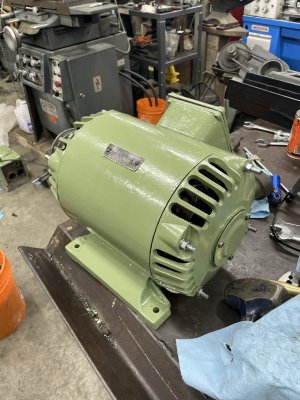


This Old Tony might have a timely answer... He details his exact process and gives good info:multiple ways to approach the repair.
DPittman
Ultra Member
I'd braze it myself. I don't think you have anything to loose. Matter of fact if you do a poor job you can unbraze it and try again or go to plan B. Make sure you V out the Crack some for braze fill and grind to clean metal. I've brazed various things with good success. I don't have the equipment and experience with welding cast iron and so my few attempts at have not been successful but it appears that is a very good solution if you know what your doing.
One of the brazings of cast iron I did that turned out surprisingly well was with the jaws of a bench vise. I was unmercifully twisting on a pipe in the jaws of a big 6" cheap Asian vise when and the jaws on one side broke out. LOTS of heat and braze rod but the repair has been successful and that was 6-8 years ago.
One of the brazings of cast iron I did that turned out surprisingly well was with the jaws of a bench vise. I was unmercifully twisting on a pipe in the jaws of a big 6" cheap Asian vise when and the jaws on one side broke out. LOTS of heat and braze rod but the repair has been successful and that was 6-8 years ago.
The 'welding' thing is more like a hybrid brazing/welding. it uses 80-90% nickel riods to 'weld' the pieces together...I don't have the equipment and experience with welding cast iron
Ok, no point whining about it, my fault, but in looking at the casting ends, was there something at work here already? Look at the casting where it attached to the webbing, specifically the discoloration. Is this an indicator of anything (rust/oil/seepage, an existing crack?)
Stop fussing. It was not your fault. That is a very typical cast iron failure mode. It was cracked before you did anything.


